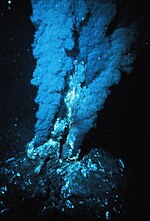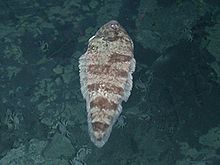
Back منفس مائي حراري Arabic Fonte hidrotermal AST Хидротермален комин Bulgarian জলতাপীয় রন্ধ্র Bengali/Bangla Hidrotermalni otvori BS Fumarola hidrotermal Catalan Hydrotermisk væld Danish Tiefsee-Hydrothermalquelle German Hydrothermal vent English Hidroterma fonto Esperanto



A hydrothermal vent is an opening in the seabed of the Earth by which geothermal energy escapes. Sea water enters, becomes very hot, and rises. The hottest ones carry many black chemicals and are called black smokers. Scientists have found fewer white smokers. Heat escapes from underground in many places. If they are on land, they are usually hot springs, geysers, or fumaroles. Many archaea and bacteria live near hydrothermal vents. They support giant tube worms, clams and shrimp, and many other eukaryotes. The earliest known life forms are thought to have lived near such vents.[1]
- ↑ Dodd, Matthew S.; Papineau, Dominic; Grenne, Tor; slack, John F.; Rittner, Martin; Pirajno, Franco; O'Neil, Jonathan; Little, Crispin T. S. (2 March 2017). "Evidence for early life in Earth's oldest hydrothermal vent precipitates". Nature. 543 (7643): 60–64. Bibcode:2017Natur.543...60D. doi:10.1038/nature21377. PMID 28252057. S2CID 2420384. Archived from the original on 16 February 2019. Retrieved 17 December 2018.
{{cite journal}}: CS1 maint: bot: original URL status unknown (link)